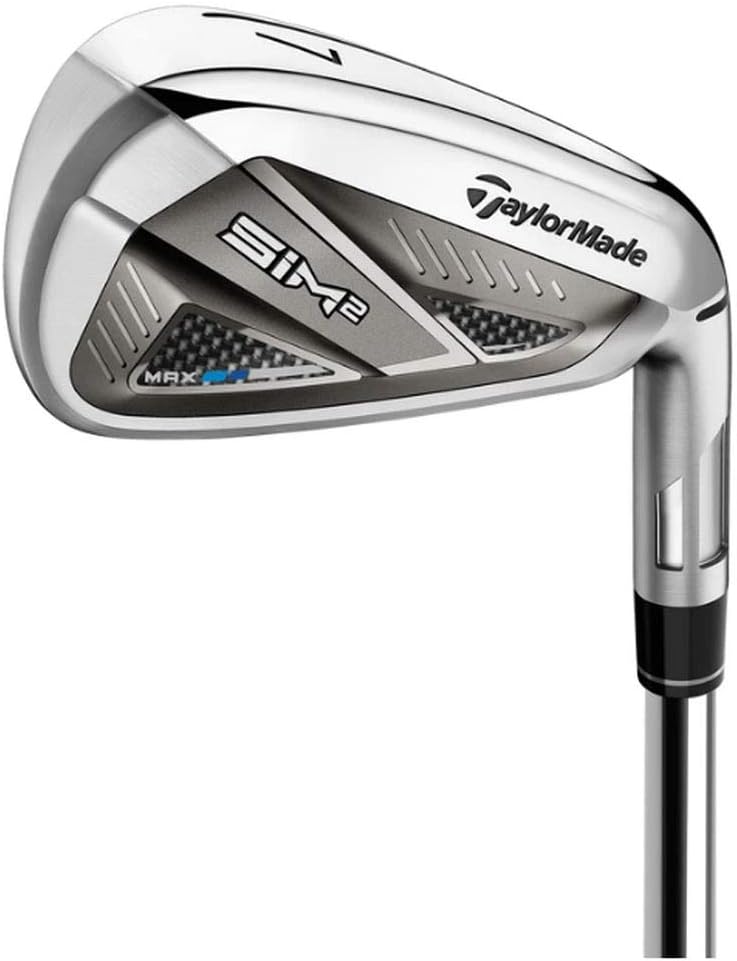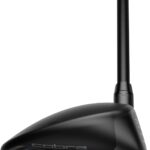Thinking about upgrading your irons — are the TaylorMade SiM 2 Max Iron Set Mens the right choice for your game?
Quick take
You’ll notice these irons are built to help you hit longer, straighter shots with a forgiving feel. They’re clearly aimed at players who want modern distance technology without losing too much of the responsive feel you expect from a quality iron.
What TaylorMade promises and why it matters
TaylorMade markets the SiM 2 Max as a multi-material, high-forgiveness set with improved feel and ball speed. If you prioritize consistency and distance on mis-hits, the engineering choices in this set are meant to give you more confidence around the course.
Design and construction overview
The SiM 2 Max irons combine stainless steel and polymers in a cap-back construction that shifts weight low and toward the perimeter. That low center of gravity (CG) and redistributed mass are intended to make launch easier and keep mishits closer to the target.
Cap Back Design
The Cap Back Design pairs high-strength stainless steel with ultralight polymers to create a hollowed cap behind the face. This construction gives you a lower CG and lets TaylorMade tune forgiveness and feel separately across each iron.
Fast Forgiving Face
TaylorMade calls the face “fast and forgiving,” meaning it’s engineered to maximize ball speed across a larger area. You’ll likely see more distance on off-center strikes compared with older cavity-back designs.
ECHO Damping System
The ECHO Damping System uses a softer polymer blend connected at multiple contact points across the face to channel vibrations away. You should feel a smoother, more forged-like sensation at impact rather than a harsh, hollow thwack.
Thru-Slot Speed Pocket
The patented Thru-Slot Speed Pocket enhances face flexibility, especially for shots struck low on the face. If you tend to catch hybrids or long irons a bit fat, this helps maintain ball speed and height on those strikes.
Progressive Inverted Cone Technology
Each iron face has an inverted cone positioned for that specific loft and face geometry to reduce sidespin on common misses. That tuning is meant to reduce the severity of a right miss for right-handed players, helping your ball stay closer to line.
Tech features and benefits (table)
Below is an easy-to-scan breakdown of the main technologies and what they give you on the course.
| Feature | What it is | Benefit to your game |
|---|---|---|
| Cap Back Design | Multi-material cap with stainless steel + ultralight polymers | Lowers CG for easier launch and improved forgiveness |
| Fast Forgiving Face | High-speed face engineered for stability | More ball speed across a larger sweet spot |
| ECHO Damping System | Soft polymer blend with multiple contact points | Smoother, forged-like feel and reduced harsh vibration |
| Thru-Slot Speed Pocket | Slot behind the sole that increases face flexibility | Maintains ball speed and height on low-face strikes |
| Progressive ICT | Inverted cone location tailored per iron | Reduces side spin and corrects common directional misses |
Look and feel at address
From the address position, these irons appear slightly larger than players’ cavity-backs but not as bulky as oversized game-improvement heads. You’re likely to find the head shape and offset reassuring if you prefer a little help aligning your shots and squaring the face at impact.
Topline, sole, and offset
The topline is moderate, offering a balance between confidence and workability, while the sole is a touch wider to aid turf interaction. There’s noticeable, but not excessive, offset designed to help square the face at impact and reduce the tendency to slice.
Sound and tactile feedback
Thanks to the ECHO Damping System and the polymer cap, the sound is more muted and pleasant compared with thin-cavity irons. You’ll still get enough feedback to know how well you struck the ball, but harsh vibrations are minimized.
Performance: distance and ball speed
You should see strong ball speeds thanks to the face engineering and energy transfer across the clubface. On-center strikes will be long and lively, and even off-center hits will retain respectable distance because the face design spreads performance across a wider area.
Launch and trajectory
The low CG helps produce a higher launch that’s easier to control for mid- and high-handicap players. If you struggle to hit enough height with your irons, these should help you carry hazards and hold greens more often.
Consistency and dispersion
Because TaylorMade tailored aspects like inverted cone placement per iron, you’ll experience more predictable misses that tend to be less penalizing. That means fewer wayward shots and improved scoring opportunities for you, especially on approach shots.
Forgiveness on mishits
Forgiveness is one of the headline strengths of this set, which is why many players who prefer more stable, confidence-inspiring clubs will gravitate toward them. The combination of perimeter weighting, Thru-Slot Speed Pocket, and progressive ICT all work to keep your results closer to target on off-center strikes.
Low-face hits
If you tend to hit low on the face, the Thru-Slot Speed Pocket helps retain ball speed and launch. That design mitigates the “blow up” shot and keeps your long irons playable.
Heel and toe misses
Perimeter weighting and the Cap Back Design reduce the drop-off in ball speed and accuracy on heel and toe strikes. You’ll often find that those misses don’t cost you as many yards or as much directional control as they would with a more compact iron.
Short game and scoring clubs
The SiM 2 Max irons are focused on distance and forgiveness, but you can still expect usable performance into the green and from around the collar. The PW and short irons are designed to offer better control, while the longer irons provide the launch and stability you need for full shots.
Partial shots and control
When you hit 3/4 or 1/2 swings, the forgiveness helps maintain consistent distances. You may not get the same spin control as a compact player’s iron, but the result is reliable and easier to dial in.
Around the green feeling
You’ll likely prefer chipping and delicate shots with a wedge or a shorter blade, but the short irons here are decent for bump-and-run shots. If you like to spin the ball aggressively on pitches and full wedge shots, consider pairing the set with wedges that have higher spin characteristics.
Turf interaction and sole performance
The sole geometry helps the club glide through turf effectively and reduces digging tendencies for most swing types. If you play on tight lies or in soft conditions, you should find that the irons are forgiving and consistent.
Best lies and conditions
These irons perform well off tee, fairway, and modest rough; however, in very thick rough you’ll always be challenged by longer hosel-length clubs. The wider sole aids launch from a variety of conditions, giving you more options during recovery shots.
Playability: shot shape and workability
While primarily focused on forgiveness, the head design still lets you shape shots to an extent. You can hit draws and fades if you’re comfortable with face manipulation and trajectory control, but extreme shot-shaping is limited compared with players’ blades.
Workability limits
You can make modest adjustments to shape and flight, but the mass distribution and perimeter weighting mean these irons are optimized for stability over extreme workability. If you need to hump a low fade into wind or flight a punched knock-down, you’ll manage, but with less precision than a compact iron.
Who should buy the TaylorMade SiM 2 Max Iron Set Mens
If you’re seeking more distance, a forgiving face, and a pleasant feel without walking up to an oversized set, these irons are a strong choice. They’re especially suited for mid-handicap players and high-handicap golfers who want confidence and consistency in approaches.
Not ideal for better players
If you’re a low handicapper who wants full shot-shaping control, feedback, and the traditional look of a forged iron, you might prefer a player’s cavity or muscle-back. You’d sacrifice some of the forgiveness and added distance of the SiM 2 Max.
Fitting and shaft considerations
A proper fitting will maximize what these irons can do for your game, and shaft choice will strongly influence launch, feel, and dispersion. You’ll want to test different flexes, weights, and materials to match your swing speed and preferred ball flight.
Steel vs graphite shafts
Graphite shafts reduce vibration and can increase clubhead speed for many players, helping distance and comfort. Steel shafts provide better feedback and control for players with faster swing speeds; choose based on feel and launch tendencies.
Flex selection and tip trimming
Make sure you’re fitted for flex and length based on your tempo and natural swing speed, and be mindful that tip trimming and lie adjustments can fine-tune launch and direction. A fitting can also help you select a set composition that fills your distance gaps efficiently.
On-course testing protocol (how you should try them)
When you demo these irons, hit full shots, 3/4 shots, and approach shots into the wind and downwind to judge consistency. Test a range of lies — tight fairway, light rough, and a tight tee shot — to see how the Thru-Slot and Cap Back Design translate to real course play.
Numbers to look for
Track ball speed, carry distance, launch angle, and dispersion compared with your current irons. But also trust feel — if you leave the session feeling more confident and less likely to “skull” or “chunk” shots, that’s valuable feedback beyond numbers.
Maintenance and care
Keep the grooves clean after each shot to retain spin characteristics, and wipe the face and sole with a damp cloth after your round. Avoid leaving clubs in extremely hot or freezing environments (like inside a car trunk for long periods) as the polymer elements can be sensitive to temperature extremes.
Cleaning tips
Use a soft brush and mild soap solution to clean grooves and the face; a toothbrush works well for stubborn dirt. Dry clubs thoroughly and store them in a dry place with headcovers for longer-term protection.
Alternatives to consider
If you like the SiM 2 Max profile but want something slightly different, look at TaylorMade’s other models and competitors’ game-improvement lines. Many golfers compare these to Callaway’s Rogue/ST/MAX family or Ping’s G-series, all of which emphasize distance and forgiveness.
Comparing with similar models
Callaway and Ping often trade blows in terms of forgiveness and feel — some players prefer Callaway’s face technology for speed, while others like Ping’s stability and simple shape. Test multiple sets to find which sound and feel match your preferences.
Pros and cons (table)
This table helps you weigh the most important strengths and trade-offs quickly.
| Pros | Cons |
|---|---|
| Strong ball speed and distance | Less shot-shaping control than players’ irons |
| High forgiveness across the face | Larger head may not appeal to players seeking minimal offset |
| Smooth, muted feel via ECHO Damping | Polymer components sensitive to extreme temps (care required) |
| Easy launch and consistent trajectory | Premium price point for a multi-material iron |
Price and value
You’ll typically pay a premium for current Taylormade technology, but the value comes from playability and confidence gains. If these irons help you save shots by keeping you in play and closer to greens, the investment can be justified through improved scores and enjoyment.
How to justify the cost
Factor in longevity, possible resale value, and the performance increase during a typical round. If these clubs drop your handicap or reduce penalty strokes, the ROI becomes clearer.
Practical tips for getting the most from these irons
Work with a fitter to dial in shaft choice and set makeup, and spend time on the range hitting different partial swings. Pair the irons with a putter and wedges that complement their launch and feel so your whole scoring game is balanced.
Adjusting your setup
Small posture and ball position changes can affect launch and spin dramatically with these clubs, so experiment until you find the setup that maximizes carry and dispersion for you. Keep your weight shift and tempo consistent to leverage the forgiveness the design offers.
Frequently asked questions
You’ll likely have questions about compatibility and performance; here are answers to common ones.
Are these irons for beginners?
They suit beginners who want forgiveness and easier launch, but complete beginners may also consider a hybrid-heavy set while learning. If you’re focused on improving approach consistency, these are a good long-term option.
Can you work the ball with this set?
Yes, but only to a moderate extent; expect to shape shots within a limited window rather than with surgical precision. The design favors stability over extreme workability.
How do I choose the right shaft?
Go to a certified fitter and test shaft flexes, weights, and materials to match your swing speed and launch preferences. Your fitter can measure ball flight and spin to recommend the best combination.
Final verdict
If you want a modern, forgiving iron set that increases ball speed, launches easily, and gives a pleasant, muted feel at impact, the TaylorMade SiM 2 Max Iron Set Mens should be near the top of your list. You’ll gain confidence from the technology and likely see more consistent approach shots, especially if you get fitted properly.
Last thoughts before you buy
Try before you buy and compare a couple of heads and shaft combinations in a fitting session to be sure the set complements your swing. Once dialed in, these irons deliver a powerful blend of distance, forgiveness, and a refined feel that will improve many golfers’ rounds.
Disclosure: As an Amazon Associate, I earn from qualifying purchases.













